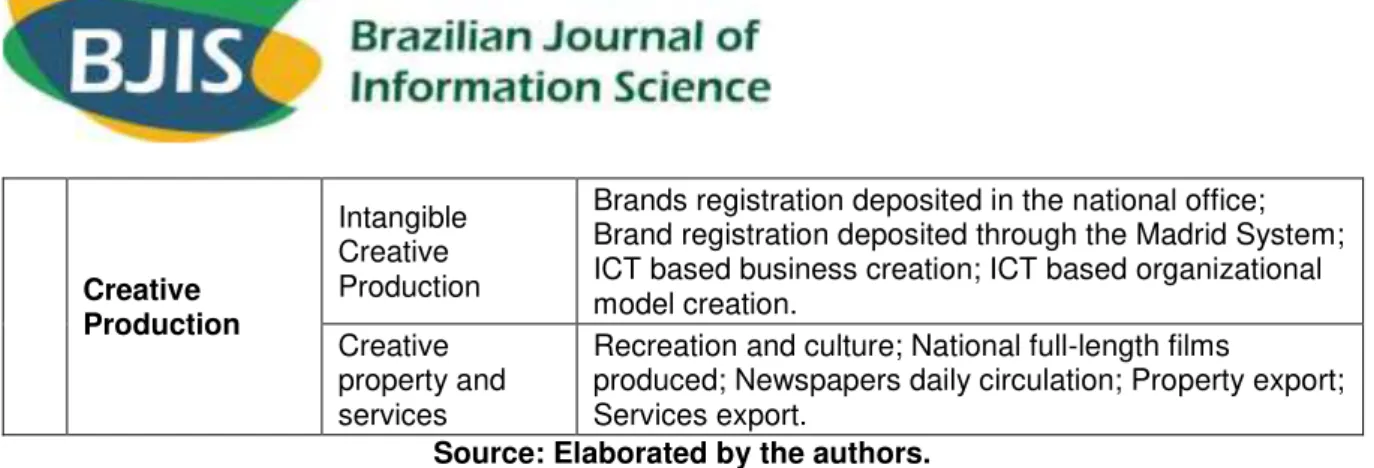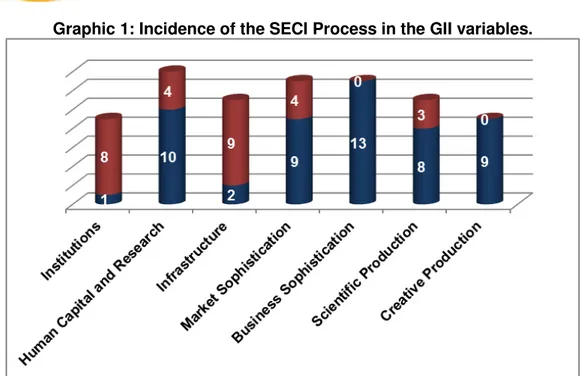THE KNOWLEDGE CONVERSION SECI PROCESS
AS INNOVATION INDICATOR ANALYSIS FACTOR
Elaine da Silva
Master Student Graduate Program in Information Science
Universidade Estadual Paulista (Unesp)
Brazil
Marta Lígia Pomim Valentim
Professor Graduate Program in Information Science
Universidade Estadual Paulista (Unesp)
Brazil
ABSTRACT
It highlights the innovation importance in the current society and presents innovation indicators applied in 125 countries. We made an analysis in the 80 variables distributed through seven GII pillars, trying to identify the direct, indirect or null incidences of the knowledge conversion way described by the SECI Process. The researched revealed the fact that knowledge management, in this case specifically the knowledge conversion SECI Process, is present in the variables that, according to the GII, make clear innovative activity in countries.
Keywords:Knowledge Management; SECI Process; Innovation Creation; Innovation
Indicators.
1 INTRODUCTION
Information Society or Knowledge Society are coined expressions to describe the current society (QUÉAU, 1998; MATELLART, 2000; WERTHEIN, 2000; CASTELLS, 2007), characterized by economic relations, global scale production and information and communication technologies (ICT) that allow information production, dissemination and sharing in a dynamic way and in real time. It´s information and knowledge based economy, with highly competitive and internationalized markets. Innovative activity in industrial organizations, described by Schumpeter (1982) at the beginning of the 20th century as “[...] new material and labor force combination”
We understand by innovation the implementation of a product or service, of a productive process, of a marketing method or a new or significantly improved organizational method, locally, regionally, nationally or globally. Literature confirms that innovation is, nowadays, one of the main factors to industrial development and competitiveness and among nations (PORTER, 1986; FLEURY, 2008; GIBSON, 2008).
In this new social model, innovation embraces government policies, governmental agency programs and entrepreneurial growth strategies (RAMOS, 2008), which influences in the necessity of innovative activities measurement indicators establishment.
2 INNOVATION INDICATORS
The first initiative related to systemically innovation analysis and measurement are attributed to the Organization for Economic Co-Operation and Development (OECD), that aims to promote politics to insure economic and social well-being, and is represented in 34 countries, including European countries (headquarters of the organization), North America members, South America and Asia (A PROPOS..., 2012).
In 2007 arises the Global Innovation Index (GII) under the leadership of The Business School for the World (INSEAD) (teaching and research institution present in Asia, North America and Europe) that has partners such as the World Intellectual Property Organization (WIPO) and the Confederation of Indian Industries. The GII 2011 edition presented data from 125 economies corresponding to 93.2% of the world population and 98% of the World Gross Domestic Product (DUTTA, 2011).
Table 1: GII Pillars and Sub-pillars.
Pillars Subpilares Variables
Inp
u
ts
Institutions
Politic
Environment Political stability; Government effectiveness; Freedom of press. Regulatory
Environment Regulatory quality; Rule of law; Rigidity of Labor. Business
Environment Press opening time; Company opening cost; Overall tax rate.
Human Capital and Research
Education
Education Expenditure; Education Public Spending per Student; School Life Expectancy; Reading Evaluation; Student-teacher relationship.
Higher Education
Higher education enrollment; Science graduated;
Engineering graduated; Foreign; Students in the country; Students in other countries; Other countries enrolment because of the total of enrollments.
Research and
Development Researches; I&D Expenditure; Research Institutions Quality.
Infrastructure
Information and
Communication ICT access; ICT use; Government online services offer and accessibility; Governance online tools use.
Energy Electricity Production; Electricity Consumption; GDP by energy consumption unity; Renewable energies quote in energy consumption.
General Infrastructure
Commerce and transportation related to infrastructure; Gross capital formation (fixed); Biocapacity and ecological resources consumption.
Market
Sophistication
Credit Legal apparatus to credit obtaining; Information Depth; Intern Credit to Private Sector; Gross credit portfolio of microfinance institutions.
Investment Investor’s protection force; Market capitalization; Overall value of stock commercialization; Risk business capital.
Commerce and Competition
Applied tariff; Commercial market access tightening; Property and services imports; Property and services export; Local competition intensity.
Business Sophistication
Knowledge Workers
Knowledge intensive services job; Companies that offer formal training; P&D Gross expenses per business company; P&D Gross expenses financed by business companies.
Innovation Links
I&D university/industry cooperation; Development state of a cluster; P&D gross expenses financed abroad; Joint
ventures/strategical partnerships and offers; Published
patents with at least on external inventor. Knowledge
Absorption High technologies import; Communication and computer service import; Foreign direct net investment.
O u tp u ts Scientific Production Knowledge Creation
Patent requests deposited in the national office; Patent requests deposited through PCT; Deposited utility model application; Publication of scientific and technique articles in magazines.
Knowledge
Impact GDP growth by employee person; New business depth; Computer software expenses. Knowledge
Diffusion
Creative Production
Intangible Creative Production
Brands registration deposited in the national office; Brand registration deposited through the Madrid System; ICT based business creation; ICT based organizational model creation.
Creative property and services
Recreation and culture; National full-length films
produced; Newspapers daily circulation; Property export; Services export.
Source: Elaborated by the authors.
Using as a principle the literature premise that knowledge is the main element that promotes innovation in organizations (LUNDVALL, 2010; TAKEUCHI; NONAKA, 2008) we search to establish the relation among the four knowledge conversion ways established by Takeuchi and Nonaka (2008) known in literature as SECI Process and the variables that the GII is consisted of.
According to the SECI Process, knowledge is created by the individual and it can be organizationally amplified by tacit knowledge conversion and vice versa. Nonaka and Takeuchi (2008) identify four knowledge conversion ways: (1) Socialization: tacit to tacit; (2) Externalization: tacit to explicit; (3) Combination: explicit to explicit; (4) Internalization: explicit to tacit. Knowledge conversion ways combine and interact in a spiral movement, they create new knowledge and, as a result, they can create innovation.
Figure 1: SECI – Knowledge conversion process.
Assuming that innovation creation is a result of public and private agents action, derivative from the manufacture, scientific, service and institutional sectors (FISCHER, 2000 apud PORCARO, 2005), knowledge conversion ways described in
the SECI Process are fundamental so through the interaction of different agents in an innovation system, each agent knowledge can be shared with the others, making possible greatest and better innovation creation possibilities.
3 METHOD AND DATA ANALYSIS
Based on what was previously explained, we made an analysis in the 80 through seven GII pillars, trying to identify the direct, indirect or null incidence of knowledge conversion ways described by the SECI Process SECI (TAKEUCHI; NONAKA, 2008).
In any of the variables was identified the total absence of the knowledge conversion process, considering that all of them use some knowledge way. In 51 of the variables, corresponding to 63,75% of the total, we noticed the direct presence of the SECI Process, which means that they are indicators that are essentially product or they depend on at least one of the knowledge conversion ways. In the remaining 29 variables (36.25%), we identified the presence of knowledge conversion only in the indirect way.
Graphic 1: Incidence of the SECI Process in the GII variables.
Source: Elaborated by the authors.
4 FINAL CONSIDERATIONS
The innovation indicators measurement, monitoring and analysis, as presented by the GII, are extremely important to the development of national innovation politics. The pillars presented in the GII show the relevance of creating an innovation environment, made of agents from the political-governmental; educational and research; infrastructure; market and business spheres. They allow governments and all Innovation National Systems (SNI) to verify their efforts in different innovation creation influencing environments.
We highlight that the pillars: Human Capital and Research; Business Sophistication; Scientific Production and Creative Production are clearly knowledge intensive indicators, focusing in education and research; fact shown in variable percentage that, in these pillars, have direct incidence in the SECI Process.
Overall, the direct or indirect incidence of the Knowledge conversion SECI Process in all variables confirms that knowledge is the most important resource in the current economy.
according to the GII, show innovative activity in the countries. This means that we have to consider that, the adoption of knowledge management models in a systemic manner at the organizations may be a differential in innovation creation and, as a result, in nation’s development.
REFERENCES
CASTELLS, M. A sociedade em rede. São Paulo: Paz e Terra, 1999. 617p. (A Era
da Informação: economia, sociedade e cultura, v.1)
DUTTA, S. (Ed.). The global innovation index 2011: Accelerating growth and
development. Available: <http://www.globalinnovationindex.org/gii>. Access: Nov. 2, 2011.
FLEURY, M. T. L.; OLIVEIRA JR., M. M. (Org.). Gestão estratégica do
conhecimento: integrando aprendizagem, conhecimento e competências. São
Paulo: Atlas, 2008.
GIBSON, R.; SKARZYNSKI, P. Inovação: prioridade n.1: o caminho para
transformação nas organizações. Rio de Janeiro: Elsevier, 2008. 300p.
LUNDVALL, B-A. (Ed.). National systems of innovation: Towards a theory of
innovation and interactive learning. London: Anthem Press, 2010. 388p.
MANUAL de Oslo: diretrizes para coleta e interpretação de dados sobre inovação. 3.ed. [S.l.p.]: OECD; FINEP, 1997. 184p.
MATTELART, A. História da sociedade da informação. São Paulo: Loyola, 2002.
196p.
PORTER, M. E. Competition in global industries. Boston: Harvard Business
School Press, 1986. 567p.
A PROPOS de l'Organisation de Coopération et de Développement Économiques (OCDE). Available:
<http://www.oecd.org/pages/0,3417,fr_36734052_36734103_1_1_1_1_1,00.html>. Access Jun. 02, 2012.
QUÉAU, P. A revolução da informação: em busca do bem comum. Ciência da Informação, Brasília, v.27, n.2, p.198-205, maio/ago. 1998.
PORCARO, R. M. Indicadores da sociedade atual - informação, conhecimento, inovação e aprendizado intensivos: a perspectiva da OECD. DataGramaZero, Rio
RAMOS, M. Y. Evolução e novas perspectivas para a construção e produção de indicadores de ciência, tecnologia e inovação. Encontros Bibli: Revista Eletrônica
de Biblioteconomia e Ciência da Informação, Florianópolis, v.13, n.esp., 1º sem. 2008. Available:
<http://www.brapci.ufpr.br/documento.php?dd0=0000006862&dd1=855df>. Access: Jun. 08, 2012.
SCHUMPETER, J. A. Teoria do desenvolvimento econômico. São Paulo: Abril
Cultural, 1982.
TAKEUCHI, H.; NONAKA, I. Gestão do conhecimento. Porto Alegre: Bookman,
2008.
WERTHEIN, J. A sociedade da informação e seus desafios. Ciência da Informação, Brasília, v.29, n.2, p.71-77, maio/ago. 2000.
Elaine da Silva
Master Student Graduate Program in Information Science Universidade Estadual Paulista (Unesp)
E-Mail: elainesilva2108@hotmail.com Brazil
Marta Lígia Pomim Valentim
Professor Graduate Program in Information Science Universidade Estadual Paulista (Unesp)

